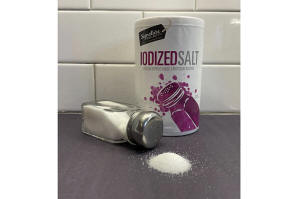Doctors worry that iodine deficiency — a dietary problem from the past —
is coming back
 Send a link to a friend
Send a link to a friend
 [January 07, 2025]
By MIKE STOBBE [January 07, 2025]
By MIKE STOBBE
NEW YORK (AP) — The 13-year-old boy came to the clinic with a rapidly
ballooning neck. Doctors were puzzled.
Testing ruled out their first suspicion. But further tests pinpointed
what they — and the boy — had been missing: iodine.
A century ago, iodine deficiency affected kids across large swaths of
the country. It essentially disappeared after some food makers started
adding it to table salt, bread and some other foods, in one of the great
public health success stories of the 20th century.
But today, people are getting less iodine because of changes in diet and
food manufacturing.
Although most people are still getting enough, researchers have
increasingly been reporting low levels of iodine in pregnant women and
other people, raising concerns about an impact on their newborns. And
there is also a very small, but growing, number of reports of iodine
deficiency in kids.
“This needs to be on people’s radar,” said Dr. Monica Serrano-Gonzalez,
a Brown University doctor who treated the boy in 2021 in Providence,
Rhode Island.

What is iodine?
Iodine is a trace element found in seawater and in some soils — mostly
in coastal areas. A French chemist accidentally discovered it in 1811
when an experiment with seaweed ash created a purple puff of vapor. The
name iodine comes from a Greek word meaning violet-colored.
Later that century, scientists began to understand that people need
certain amounts of iodine to regulate their metabolism and stay healthy,
and that it’s crucial in the development of brain function in children.
One sign of insufficient iodine is a swelling of the neck, known as a
goiter. The thyroid gland in the neck uses iodine to produce hormones
that regulate the heart rate and other body functions. When there's not
enough iodine, the thyroid gland enlarges as it goes into overdrive to
make up for the lack of iodine.
At the beginning of the 20th century, goiter was very common in children
in certain inland parts of the United States, especially in a “goiter
belt” that stretched from Appalachia and the Great Lakes to the
northwest United States. Some of the kids were unusually short, deaf,
intellectually stunted and had other symptoms of a syndrome once known
as “cretinism.”
Adding iodine to salt
Public health experts realized they couldn't solve the problem by
feeding everyone seaweed and seafood, but they learned that iodine can
essentially be sprayed on table salt. Iodized salt first became
available in 1924. By the 1950s, more than 70% of U.S. households used
iodized table salt. Bread and some other foods also were fortified with
iodine, and iodine deficiency became rare.

[to top of second column]
|

Iodized salt is displayed for a photograph in Philadelphia on
Monday, Jan. 6, 2025. (AP Photo/Jonathan Poet)
 But diets changed. Processed foods
now make up a large part of the American diet, and though they
contain a lot of salt, it's not iodized. Leading bread brands no
longer add iodine. In the case of the 13-year-old boy, he has mild
autism and was a fussy eater, mostly only eating specific brands of
bread and peanut butter.
And for people who do salt their food, the fashion
now is to use kosher salt, Himalayan rock salt or other noniodized
products.
“People have forgotten why there's iodine in salt,” said Dr.
Elizabeth Pearce of Boston Medical Center. She is a leader in the
Iodine Global Network, a nongovernmental agency working to eliminate
iodine deficiency disorders.
She noted a reported 50% drop in U.S. iodine levels in surveyed
Americans between the 1970s and the 1990s.
How much iodine is enough?
Though iodine consumption is falling overall, most Americans are
still getting enough through their diet, experts say. But doctors
worry that's not the case for women and children, who are most
vulnerable to iodine deficiency.
The American Academy of Pediatrics and other medical societies
recommend that all pregnant and breastfeeding women get 150
micrograms of iodine each day. You can get that from one-half to
three-quarters of a teaspoon of iodized table salt.
In the last 15 years or so, U.S. researchers have increasingly
reported seeing mild iodine deficiency in pregnant women. A Michigan
State University study of about 460 pregnant women in the city of
Lansing found about a quarter of them were not getting enough.
Many prenatal vitamins don't contain iodine, noted Jean Kerver, the
study's lead author. That's why doctors recommend that pregnant or
breastfeeding women check labels to ensure they are taking
multivitamins or prenatal supplements with iodine.

Some studies have linked even mild iodine deficiency to lower IQs
and language delay in children, although there is debate about at
exactly what levels problems start, Pearce said.
Experts say there hasn't been enough research to establish what
impact that iodine deficiency has actually been having on the U.S.
population in recent years.
Serrano-Gonzalez said she and her colleagues have seen four other
cases in children in their clinic in Providence.
“We’re concerned this may be increasing, especially in patients with
restricted diets," she said.
All contents © copyright 2024 Associated Press. All rights reserved |